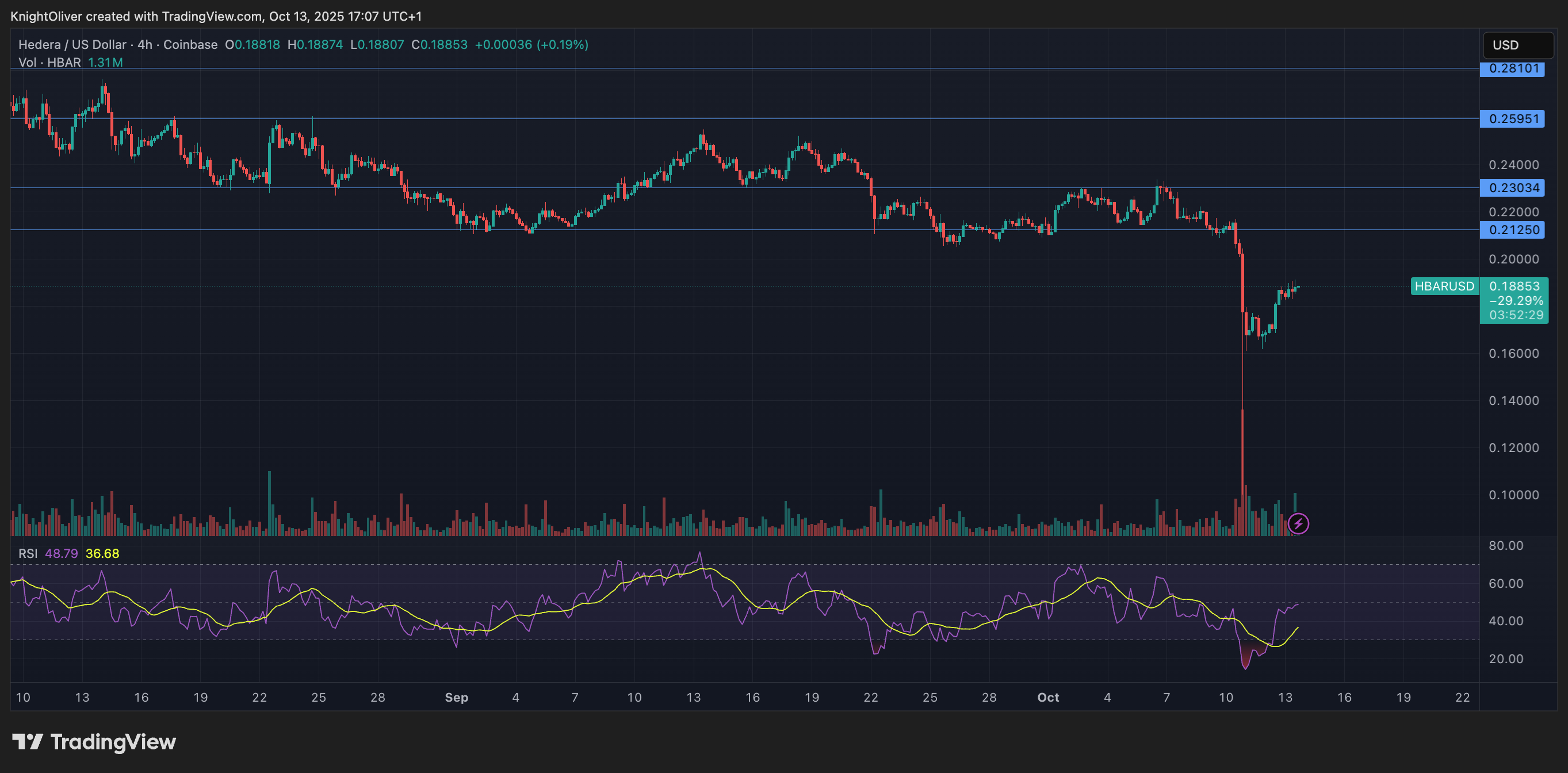Uncategorized
U.S. Marshals Service Can’t Say How Much Crypto It Holds, Complicating Bitcoin Reserve Plan

The U.S. Marshals Service (USMS) is tasked with managing assets seized by law enforcement in the course of criminal investigations, like real estate, cash, jewelry, antiques or vehicles.
It is also supposed to be handling cryptocurrencies — for example, the billions of dollars worth of bitcoin (BTC) seized by the Federal Bureau of Investigation (FBI) from darknet marketplace Silk Road in 2013.
However, the USMS doesn’t seem to know how much crypto it currently has. In fact, the agency is struggling to come up with a rough estimate of even its bitcoin holdings, a source familiar with the matter told CoinDesk.
That could be a problem, in light of White House Crypto Czar David Sacks’ announcement earlier this month that the U.S. government is actively studying the possibility of constituting a national crypto reserve — meaning that the government might stop liquidating seized cryptocurrencies, and even potentially make crypto purchases.
“When you start talking about reserves, you need to be familiar with the unique properties of the assets, like forks, airdrops, and the constant volatility,” said Les Borsai, co-founder of Wave Digital Assets, a firm that provides asset management services and has been in a dispute with the USMS over not getting hired as a contractor, in an interview with CoinDesk. “You have to have the agencies educated enough or dealing with professionals that understand how to help them achieve their goals.”
Even if the crypto reserve never sees the light of day, managing and liquidating seized digital assets is a crucial role for the agency, especially since asset forfeiture is used to help fund the Department of Justice (DOJ).
“As far as I’m aware, the USMS is currently managing this with individual keystrokes in an Excel spreadsheet,” Chip Borman, vice president of capture strategy and proposals at Addx Corporation, a firm that provides technological solutions to the U.S. government and was also turned down for a USMS contract, told CoinDesk. Borman said he saw USMS processes occur in real time in 2023.
“They’re one bad day away from a billion-dollar mistake.”
USMS history of crypto management
The agency’s troubles with crypto aren’t new. Timothy Clarke, CEO of crypto consulting firm ECC Solutions, told CoinDesk that a lot of frustration had built up against the USMS from both the public and private sectors over the years.
As recently as 2019, the agency “only handled a handful of cryptocurrency assets, like eight or 10, so all the different U.S. government agencies had to do their own storage, instead of the USMS doing its job and intaking seizures,” said Clarke, a former special agent at the Department of Treasury.
Not only would the USMS take weeks to provide bitcoin deposit addresses to agencies when they’d just made a seizure, he said, but the agency would simply share them over email without any sort of encryption or verification process.
At other agencies, like IRS Criminal Investigation (IRS-CI), such sensitive information is usually either communicated in video calls or via read-only encrypted attachments with follow-up calls for passwords and read-back verification of the addresses — and that’s if specialists don’t come directly on-site to handle crypto wallets themselves.
“It was very, very unsecure,” Clarke said. “It’s just shocking that nothing happened in the years they did that.”
The USMS declined to comment.
Back in 2022, the Office of the Inspector General (OIG) warned that the USMS was struggling in the management and tracking of its holdings.
“The USMS did not have adequate policies related to seized cryptocurrency storage, quantification, valuation, and disposal, and in some instances, guidance was conflicting,” the OIG said.
For example, the USMS did not have measures in place to track forked assets — cryptocurrencies that are created whenever a blockchain does a split, known in the industry as a hard fork — think Bitcoin Cash (BCH) or Bitcoin Satoshi Vision (BSV), both of which forked off of Bitcoin. “As a result, the USMS may fail to identify and track forked assets, and thereby lose the opportunity to sell those assets when they are forfeited,” the OIG said.
The spreadsheets on which the agency was relying to track its various crypto holdings also contained inaccuracies, the OIG found.
In November 2022, five months after the OIG report was published, USMS stated (while it was looking for a contractor to help it handle its crypto assets) that it had lost control of two Ethereum wallets due to a software update.
“It is unclear if the private key is incorrect, or the wallet malfunctioned,” the agency said. “The Contractor will identify the issue(s) and potentially open the wallet. If the wallet cannot be opened, documentation of efforts taken to unlock or open the wallet will be provided to the USG.”
Clarke told CoinDesk that it was unclear whether the issues with the Ethereum wallets had occurred before, during, or after the OIG audit. The OIG report itself makes no mention of mismanaged Ethereum wallets or missing ether (ETH).
“At a minimum it speaks to a lack of a backup wallet and lack of competent storage, update, and handling procedures,” Clarke said.
“The perception is that everything has remained the same since the 2022 OIG Findings,” John Millward, chief operating officer at Addx, told CoinDesk in an interview.
Millward said he understood there to be a single employee managing the assets disposal “right now on a retail account,” though the agency wasn’t available to confirm such details. He said the task had not been assigned to a senior employee “despite the massive financial responsibilities and liability this one person controls.”
Liquidating crypto ahead of stockpile decision
In July 2024, at a Bitcoin conference in Nashville, President Trump said that, if elected, he would instruct the federal government to stop selling seized bitcoin. That was an idea first pushed by Senator Cynthia Lummis (R-WY), one of bitcoin’s most vocal backers in Congress, who introduced legislation aimed towards constituting a national bitcoin reserve.
On Jan. 15, only a few days before Trump was set to take office, Lummis wrote a letter to Ronald L. Davis — who at the time was still director of the USMS — in which she expressed her alarm that DOJ attorneys appeared to be engaged in a process to liquidate the 69,370 bitcoin (worth roughly $6.6 billion) seized from Silk Road.
“Recent court filings from earlier this month show that the Department of Justice is citing bitcoin price volatility to justify an expedited sale of these assets,” she wrote.
“Even more troubling, the Department continues to aggressively push forward with liquidation plans despite pending legal challenges, demonstrating an unusual urgency to dispose of these assets,” she added. “This rushed approach, occurring during the presidential transition period, directly contradicts the incoming administration’s stated policy objectives regarding the establishment of a National Bitcoin Stockpile.”
Lummis asked the USMS (which handles seized assets, but does not make decisions with regards to liquidations) to share the total amount of bitcoin it currently holds, to explain why that information has not been made readily available in a public manner, and to describe its tracking and management procedures. The agency was given until Jan. 31 to answer, but has yet to formally respond, according to a source familiar with the matter.
The USMS has contacted Lummis’ office twice since the letter was issued, the source said, but the agency was unable to answer how much bitcoin it had under its control, blaming the shake-up caused by the change in administrations. Lummis’ office declined to comment.
Significant amounts of bitcoin are apparently being held by various agencies across the administration — including the DOJ and Department of Treasury — and the USMS has no reconciliation process to figure out where it all sits, the source said.
USMS procurement struggles
The OIG noted in 2022 that the USMS was taking proactive steps to boost its management procedures by seeking to enlist the private sector. The move would “assist the USMS in addressing some of the issues we identified,” the OIG said.
However, the agency has taken a long time to award these contracts, and its decisions have been questioned by some of the parties involved.
The USMS started looking into procurement in 2018 and first awarded the contract to crypto exchange Bitgo in April 2021. However, it was determined that the exchange did not meet the definition of a “small business” (which was one of the requirements for the contract). The award then passed on to crypto custody firm Anchorage Digital in July 2021 — yet Anchorage was also found too large to meet the small-business criteria.
The agency switched gears in 2024, awarding two different contracts: the first for the management of so-called Class 1 cryptocurrencies (meaning coins supported on centralized exchanges and in cold-storage wallets) and the second for Class 2-4 cryptocurrencies (coins that don’t meet Class 1 requirements).
Crypto exchange Coinbase won the award for Class 1 in July, while the Class 2-4 contract went in October to Command Services & Support (CMDSS), a technology service provider with experience working with the DOJ.
Controversial awarding
These awards were both contested in court. Anchorage’s protest, against Coinbase, was dismissed, but it’s unclear whether the firm has filed another protest. The U.S. government spending website suggests that Coinbase has yet to receive payment for the contract. (Anchorage declined to comment. Coinbase did not respond to a request for comment.)
The Class 2-4 award, meanwhile, is the subject of an ongoing protest by Wave, which claims that CMDSS lacks the proper licensing for the contract — CMDSS isn’t licensed with the Securities and Exchange Commission (SEC) nor the Financial Industry Regulatory Authority (FINRA) — and that the agency failed to properly investigate a conflict of interest from CMDSS employing a former USMS official with access to nonpublic information.
The USMS, for its part, has stated that the winning bidder wasn’t required to be licensed with the SEC or FINRA in the first place; the agency also claims to have properly investigated any conflicts of interest related to former USMS employees.
“If you don’t care about the basics, like being licensed to handle securities, which is the most basic understanding of handling digital assets, then what are you doing? It just shows you how little they know about the process,” Borsai said. CMDSS did not respond to a request for comment.
Addx competed against Wave and CMDSS for the contract. Nevertheless, Millward said that it would have made more sense for Wave than CMDSS to secure the award, since the firm possessed technical upside and offered to perform the work for a lower price.
“I think there’s a lot of personal trust in the leadership of the awarded entity to figure it out and not make the USMS look bad,” Millward said.
Dealing with smaller cryptocurrencies
The central theme from USMS’s critics is that the agency doesn’t sufficiently understand digital assets.
“They treat crypto like it’s a boat or a piece of real estate,” Borsai said. “The USMS could not possibly understand what they hold if they do not understand the assets. … They will never get an accurate figure, unless they go all-in on a multi-agency shared system.”
Millward and Borman said that the USMS had difficulty understanding that custody firms need the same amount of resources to manage a specific number of Class 2-4 coins regardless of whether the tokens are worth billions of dollars or merely cents.
The agency had suggested to Addx that if it won the award it may have been paid only in a percentage of the assets it would end up managing, instead of a flat fee. The agency seemed surprised when Addx explained how expensive the custody solutions would be.
“They said, ‘We anticipate never having more than $500 in value at any given time,’” Borman said. “They don’t understand that by judge’s decree, that fob that contains 20 cents worth of bitcoin needs to be tracked and analyzed, and destroying some fellow’s 20 cents is just as egregious as crashing a Lamborghini on the way to the impound lot.”
Business
Strategy Bought $27M in Bitcoin at $123K Before Crypto Crash

Strategy (MSTR), the world’s largest corporate owner of bitcoin (BTC), appeared to miss out on capitalizing on last week’s market rout to purchase the dip in prices.
According to Monday’s press release, the firm bought 220 BTC at an average price of $123,561. The company used the proceeds of selling its various preferred stocks (STRF, STRK, STRD), raising $27.3 million.
That purchase price was well above the prices the largest crypto changed hands in the second half of the week. Bitcoin nosedived from above $123,000 on Thursday to as low as $103,000 on late Friday during one, if not the worst crypto flash crash on record, liquidating over $19 billion in leveraged positions.
That move occurred as Trump said to impose a 100% increase in tariffs against Chinese goods as a retaliation for tightening rare earth metal exports, reigniting fears of a trade war between the two world powers.
At its lowest point on Friday, BTC traded nearly 16% lower than the average of Strategy’s recent purchase price. Even during the swift rebound over the weekend, the firm could have bought tokens between $110,000 and $115,000, at a 7%-10% discount compared to what it paid for.
With the latest purchase, the firm brought its total holdings to 640,250 BTC, at an average acquisition price of $73,000 since starting its bitcoin treasury plan in 2020.
MSTR, the firm’s common stock, was up 2.5% on Monday.
Business
HBAR Rises Past Key Resistance After Explosive Decline

HBAR (Hedera Hashgraph) experienced pronounced volatility in the final hour of trading on Oct. 13, soaring from $0.187 to a peak of $0.191—a 2.14% intraday gain—before consolidating around $0.190.
The move was driven by a dramatic surge in trading activity, with a standout 15.65 million tokens exchanged at 13:31, signaling strong institutional participation. This decisive volume breakout propelled the asset beyond its prior resistance range of $0.190–$0.191, establishing a new technical footing amid bullish momentum.
The surge capped a broader 23-hour rally from Oct. 12 to 13, during which HBAR advanced roughly 9% within a $0.17–$0.19 bandwidth. This sustained upward trajectory was characterized by consistent volume inflows and a firm recovery from earlier lows near $0.17, underscoring robust market conviction. The asset’s ability to preserve support above $0.18 throughout the period reinforced confidence among traders eyeing continued bullish action.
Strong institutional engagement was evident as consecutive high-volume intervals extended through the breakout window, suggesting renewed accumulation and positioning for potential continuation. HBAR’s price structure now shows resilient support around $0.189–$0.190, signaling the possibility of further upside if momentum persists and broader market conditions remain favorable.

Technical Indicators Highlight Bullish Sentiment
- HBAR operated within a $0.017 bandwidth (9%) spanning $0.174 and $0.191 throughout the previous 23-hour period from 12 October 15:00 to 13 October 14:00.
- Substantial volume surges reaching 179.54 million and 182.77 million during 11:00 and 13:00 sessions on 13 October validated positive market sentiment.
- Critical resistance materialized at $0.190-$0.191 thresholds where price movements encountered persistent selling activity.
- The $0.183-$0.184 territory established dependable support through volume-supported bounces.
- Extraordinary volume explosion at 13:31 registering 15.65 million units signaled decisive breakout event.
- High-volume intervals surpassing 10 million units through 13:35 substantiated significant institutional engagement.
- Asset preserved support above $0.189 despite moderate profit-taking activity.
Disclaimer: Parts of this article were generated with the assistance from AI tools and reviewed by our editorial team to ensure accuracy and adherence to our standards. For more information, see CoinDesk’s full AI Policy.
Business
Crypto Markets Today: Bitcoin and Altcoins Recover After $500B Crash

The crypto market staged a recovery on Monday following the weekend’s $500 billion bloodbath that resulted in a $10 billion drop in open interest.
Bitcoin (BTC) rose by 1.4% while ether (ETH) outperformed with a 2.5% gain. Synthetix (SNX, meanwhile, stole the show with a 120% rally as traders anticipate «perpetual wars» between the decentralized trading venue and HyperLiquid.
Plasma (XPL) and aster (ASTER) both failed to benefit from Monday’s recovery, losing 4.2% and 2.5% respectively.
Derivatives Positioning
- The BTC futures market has stabilized after a volatile period. Open interest, which had dropped from $33 billion to $23 billion over the weekend, has now settled at around $26 billion. Similarly, the 3-month annualized basis has rebounded to the 6-7% range, after dipping to 4-5% over the weekend, indicating that the bullish sentiment has largely returned. However, funding rates remain a key area of divergence; while Bybit and Hyperliquid have settled around 10%, Binance’s rate is negative.
- The BTC options market is showing a renewed bullish lean. The 24-hour Put/Call Volume has shifted to be more in favor of calls, now at over 56%. Additionally, the 1-week 25 Delta Skew has risen to 2.5% after a period of flatness.
- These metrics indicate a market with increasing demand for bullish exposure and upside protection, reflecting a shift away from the recent «cautious neutrality.»
- Coinglass data shows $620 million in 24 hour liquidations, with a 34-66 split between longs and shorts. ETH ($218 million), BTC ($124 million) and SOL ($43 million) were the leaders in terms of notional liquidations. Binance liquidation heatmap indicates $116,620 as a core liquidation level to monitor, in case of a price rise.
Token Talk
By Oliver Knight
- The crypto market kicked off Monday with a rebound in the wake of a sharp weekend leverage flush. According to data from CoinMarketCap, the total crypto market cap climbed roughly 5.7% in the past 24 hours, with volume jumping about 26.8%, suggesting those liquidated at the weekend are repurchasing their positions.
- A total of $19 billion worth of derivatives positions were wiped out over the weekend with the vast majority being attributed to those holding long positions, in the past 24 hours, however, $626 billion was liquidated with $420 billion of that being on the short side, demonstrating a reversal in sentiment, according to CoinGlass.
- The recovery has been tentative so far; the dominance of Bitcoin remains elevated at about 58.45%, down modestly from recent highs, which implies altcoins may still lag as capital piles back into safer large-cap names.
- The big winner of Monday’s recovery was synthetix (SNX), which rose by more than 120% ahead of a crypto trading competition that will see it potentially start up «perpetual wars» with HyperLiquid.
-

 Business12 месяцев ago
Business12 месяцев ago3 Ways to make your business presentation more relatable
-

 Fashion12 месяцев ago
Fashion12 месяцев agoAccording to Dior Couture, this taboo fashion accessory is back
-

 Entertainment12 месяцев ago
Entertainment12 месяцев ago10 Artists who retired from music and made a comeback
-

 Entertainment12 месяцев ago
Entertainment12 месяцев ago\’Better Call Saul\’ has been renewed for a fourth season
-

 Entertainment12 месяцев ago
Entertainment12 месяцев agoNew Season 8 Walking Dead trailer flashes forward in time
-

 Uncategorized4 месяца ago
Uncategorized4 месяца agoRobinhood Launches Micro Bitcoin, Solana and XRP Futures Contracts
-

 Business12 месяцев ago
Business12 месяцев ago15 Habits that could be hurting your business relationships
-

 Entertainment12 месяцев ago
Entertainment12 месяцев agoMeet Superman\’s grandfather in new trailer for Krypton





